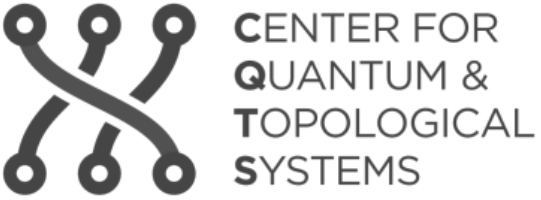Schreiber Introduction to Hypothesis H
Lecture notes that we are finalizing:
-
at Center for Quantum and Topological Systems:
Introduction to Hypothesis H on M-theory

Hypothesis H: C-field flux quantization (its non-perturbative completion) is in unstable twisted CoHomotopy.
Inaccessible before FSS23-Char due to the non-abelian higher C-field gauge algebra
C-field in nonabelian diff. cohomlg. (differential CoHomotopy).download
announcement poster:
polished part I:
-
Encyclopedia of Mathematical Physics 2nd ed4 (2025) 281-324
-
slides: Non-Linear Flux-Quantization in general [pdf]
polished part II:
-
Engineering of Anyons on M5-Probes
prepared for Srní Winter School on Geometry and Physics 18-25 Jan 2025
-
slides: Flux Quantization on probe M5-Branes [pdf]
full notes (under construction):
- [pdf] (97 pages, under development)
topic overview pages:
-
Introduction
-
[pdf] M-theory as an approach to the confinement/mass gap problem.
-
[pdf] Broad logic of flux quantization leading to Hypothesis H.
-
-
Flux Quantization
-
[pdf] Branes as concentrations of flux density forms.
-
[pdf] Distinguishing singular branes from solitonic branes.
-
[pdf] The Gauss law solution space of flux densities in higher gauge theories.
-
[pdf] Differential-topological review of Dirac charge quantization.
-
[pdf] The nonabelian character map via the fundamental theorem of RHT.
-
[pdf] The flux quantized phase space stacks via nonabelian differential cohomology.
-
-
Hypothesis H
-
[pdf] Hypothesis H: C-field flux quantization in twisted Cohomotopy.
-
[pdf] Double dimensional reduction of Hypothesis H via cyclification.
-
[pdf] Resulting M5-brane sigma-model and its -flux quantization.
-
[pdf] Solitonic brane cobordism from Cohomotopy via Pontrjagin's theorem.
-
[pdf] Exotic brane configurations from Cohomotopy via May-Segal’s theorem.
-
[pdf] Differential Cohomotopical ADHM construction and brane intersections.
-
-
Quantum observables
-
[pdf] Non-perturbative quantization of flux quantized gauge fields.
-
[pdf] Discrete light-cone quantization of topological flux observables.
-
[pdf] Quantum observables on D6-D8-brane bound states via Fadell-Husseini’s theorem.
-
[pdf] Quantum states of M2-M5 brane bound states in the BMN matrix model.
-
[pdf] Quantum observables on D4-NS5 intersections via Gelfand-Raikov theorem.
-
-
Abstract. The key open question of contemporary mathematical physics is the elucidation of the currently elusive fundamental laws of strongly-interacting “non-perturbative” quantum states — including bound states as mundane as nucleons but more generally of quarks confined inside hadrons (declared a mathematical “Millennium Problem” by the Clay Math Institute), as well as strongly-correlated topologically ordered quantum materials (currently sought by various laboratories as hardware for topological quantum computation).
The seminal strategy of regarding such systems as located on branes inside a higher dimensional string-theoretic spacetime (the “holographic principle”) shows all signs of promise but has been suffering from the ironic shortcoming that also string theory has only really been defined perturbatively, at small coupling. However, string theory exhibits a web of hints towards the nature of its non-perturbative completion, famous under the working title “M-theory” but still elusive. Thus, mathematically constructing M-theory should imply a mathematical understanding of quantum brane worldvolumes which should solve non-perturbative quantum physics: the M-strategy for attacking the Millennium Problem.
After a time of stagnation in research towards M-theory, we have recently formulated and extensively tested a hypothesis on the precise mathematical nature of at least a core part of the theory: We call this Hypothesis H since it postulates that M-branes are classified by coHomotopy-theory in much the same way that D-branes are expected to be classified by K-theory (a widely held but just as conjectural belief which might analogously be called Hypothesis K). In fact, stabilized coHomotopy is equivalently -K-theory over the “absolute base field with one element”. Last not least, coHomotopy is equivalently framed Cobordism cohomology.
In these lecture notes we try to give an introduction to (1.) the motivation and (2.) some consequences of Hypothesis H, assuming an audience with a little background in electromagnetism, differential geometry and algebraic topology.
Based on:
-
The Character Map in Non-Abelian Cohomology
World Scientific (2023)
-
and further references listed at Hypothesis H (see there).
Various parts of these lecture notes have been
presented at the following events:
-
15 Jan 2023, New York University Abu Dhabi
[video:YT]
-
NMSU Geometry & Topology Seminar
24 Feb 2023, New Mexico State University
-
Building-up differentiable homotopy theory 2023
5-8 Mar 2023, University of Aizu
-
Representations in higher structures,
27-30 June 2023, Univ. of Greifswald
-
10 Jan 2024, online
[video: YT]
-
AdS Seminar of YMSC String Theory Group at Yau Mathematical Sciences Center
11 Jan 2024, Tsinghua Univ. Beijing
-
Jan 2024, NYU Abu Dhabi
[video:kt]
-
45th Srni Winter School on Geometry & Physics
18-25 Jan 2025, Masaryk University
Related talks & lectures:
-
Introduction to Higher Supergeometry
talk at Higher Structures in M-Theory 2018
Aug 2018, Durham
-
TED K-theory of Cohomotopy moduli spaces and Anyonic Topological Order
talk at Higher Structures and Field Theory
Aug 2022, ESI Vienna
-
Twisted equivariant differential (TED) K-theory via diffeological stacks
talk at Global Diffeology Seminar
Nov 2022
-
Topological Quantum Gates from M-Theory
talk at M-Theory and Mathematics 2023
15-17 Jan 2023, CQTS @ NYU Abu Dhabi
Last revised on January 25, 2025 at 11:19:38. See the history of this page for a list of all contributions to it.
